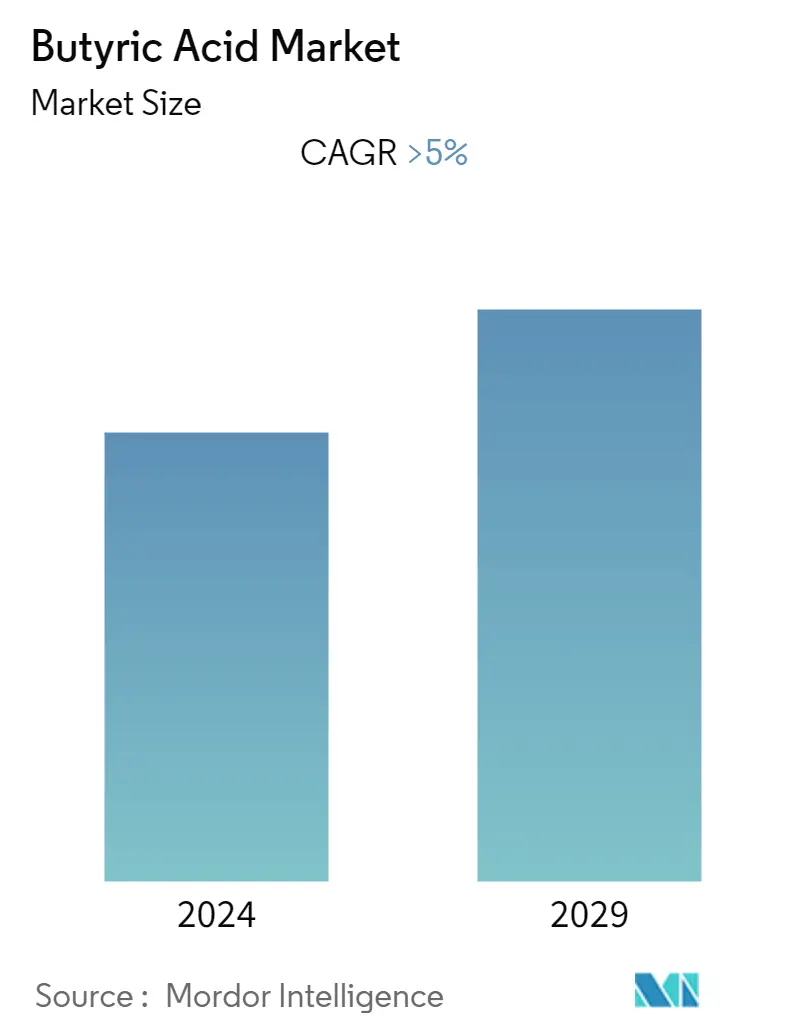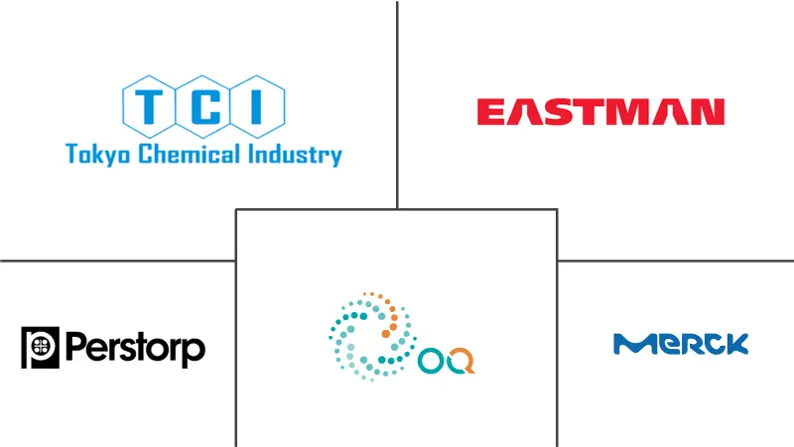Market Size of Butyric Acid Industry

| Study Period | 2019 - 2029 |
| Base Year For Estimation | 2023 |
| CAGR | 5.00 % |
| Fastest Growing Market | Asia Pacific |
| Largest Market | Asia Pacific |
| Market Concentration | High |
Major Players
*Disclaimer: Major Players sorted in no particular order |
Butyric Acid Market Analysis
The global Butyric Acid Market is projected to register a CAGR of over 5% during the forecast period.
The market was negatively impacted due to COVID-19 in 2020 owing to the pandemic scenario; several countries went into lockdown, which led to supply chain disruptions, work stoppages, and labor shortages. However, the upsurge in the application of butyric acid in the food and flavor industry propelled the industry's growth.
- Over the medium term, the rising number of food processing industries and the increasing usage of butyric acid as an intermediate drive market growth.
- Conversely, fluctuating raw materials and associated health hazards are expected to hinder market growth.
- Increasing butyric acid adoption in biofuels will likely offer new growth opportunities to the overall industry in the coming years.
- Asia-Pacific region accounted for the largest share and is expected to register the highest CAGR during the forecast period.
Butyric Acid Industry Segmentation
Butyric acid is a colorless syrupy liquid organic acid found in rancid butter and arnica oil.
The Butyric Acid Market is segmented by source, application, and geography. By source, the market is segmented into renewable butyric acid and synthetic butyric acid. By application, the market is segmented into chemical intermediates, animal feed, pharmaceuticals, perfumes, food and flavors, and other applications. The report also covers the market size and forecasts for the butyric acid market in 15 countries across major regions. For each segment, the market sizing and forecasts have been done on the basis of revenue (USD million).
| Source | |
| Renewable Butyric Acid | |
| Synthetic Butyric Acid |
| Application | |
| Chemical Intermediates | |
| Animal Feed | |
| Pharmaceuticals | |
| Perfumes | |
| Food and Flavors | |
| Other Applications |
| Geography | |||||||
| |||||||
| |||||||
| |||||||
| |||||||
|
Butyric Acid Market Size Summary
The Butyric Acid Market is poised for significant growth, driven by its increasing application in the food and flavor industry, as well as its rising use as an intermediate in food processing. Despite the initial setbacks caused by the COVID-19 pandemic, which disrupted supply chains and labor availability, the market has rebounded with a focus on biofuels and animal feed. Butyric acid's role as a key ingredient in animal feed, particularly for cattle, poultry, and aquaculture, underscores its importance in enhancing animal health and efficiency. The demand for butyric acid is further bolstered by the growing meat consumption in the Asia-Pacific region, fueled by rising incomes and urbanization, alongside the expansion of major food corporations in these markets.
The Asia-Pacific region is expected to dominate the global butyric acid market, supported by China's advanced healthcare and food processing sectors, as well as its burgeoning pharmaceutical industry. The region's rapid economic growth and increasing urbanization are driving the demand for animal-based proteins, thereby boosting the need for butyric acid in animal feed. The market is characterized by a partial consolidation, with major players like Eastman Chemical Company and Perstorp Holding AB leading the industry. Recent developments, such as the launch of innovative feed solutions and the introduction of bio-based butyric acid for animal nutrition, highlight the ongoing efforts to meet the demand for sustainable and performance-enhancing ingredients.
Butyric Acid Market Size - Table of Contents
-
1. MARKET DYNAMICS
-
1.1 Drivers
-
1.1.1 Increasing Demand from Food Processing
-
1.1.2 Increasing Usage of Butyric Acid as Intermediates
-
-
1.2 Restraints
-
1.2.1 Associated Health Hazards and Fluctuating Raw Material Prices
-
-
1.3 Industry Value Chain Analysis
-
1.4 Porter's Five Forces Analysis
-
1.4.1 Bargaining Power of Suppliers
-
1.4.2 Bargaining Power of Consumers
-
1.4.3 Threat of New Entrants
-
1.4.4 Threat of Substitute Products and Services
-
1.4.5 Degree of Competition
-
-
-
2. MARKET SEGMENTATION (Market Size in Value)
-
2.1 Source
-
2.1.1 Renewable Butyric Acid
-
2.1.2 Synthetic Butyric Acid
-
-
2.2 Application
-
2.2.1 Chemical Intermediates
-
2.2.2 Animal Feed
-
2.2.3 Pharmaceuticals
-
2.2.4 Perfumes
-
2.2.5 Food and Flavors
-
2.2.6 Other Applications
-
-
2.3 Geography
-
2.3.1 Asia-Pacific
-
2.3.1.1 China
-
2.3.1.2 India
-
2.3.1.3 Japan
-
2.3.1.4 South Korea
-
2.3.1.5 Rest of Asia-Pacific
-
-
2.3.2 North America
-
2.3.2.1 United States
-
2.3.2.2 Canada
-
2.3.2.3 Mexico
-
-
2.3.3 Europe
-
2.3.3.1 Germany
-
2.3.3.2 United Kingdom
-
2.3.3.3 France
-
2.3.3.4 Italy
-
2.3.3.5 Rest of Europe
-
-
2.3.4 South America
-
2.3.4.1 Brazil
-
2.3.4.2 Argentina
-
2.3.4.3 Rest of South America
-
-
2.3.5 Middle-East and Africa
-
2.3.5.1 Saudi Arabia
-
2.3.5.2 South Africa
-
2.3.5.3 Rest of Middle-East and Africa
-
-
-
Butyric Acid Market Size FAQs
What is the current Butyric Acid Market size?
The Butyric Acid Market is projected to register a CAGR of greater than 5% during the forecast period (2024-2029)
Who are the key players in Butyric Acid Market?
Eastman Chemical Company , Perstorp Holding AB , Merck KGaA, Tokyo Chemical Industry Co., Ltd and OQ Chemicals GmbH are the major companies operating in the Butyric Acid Market.

